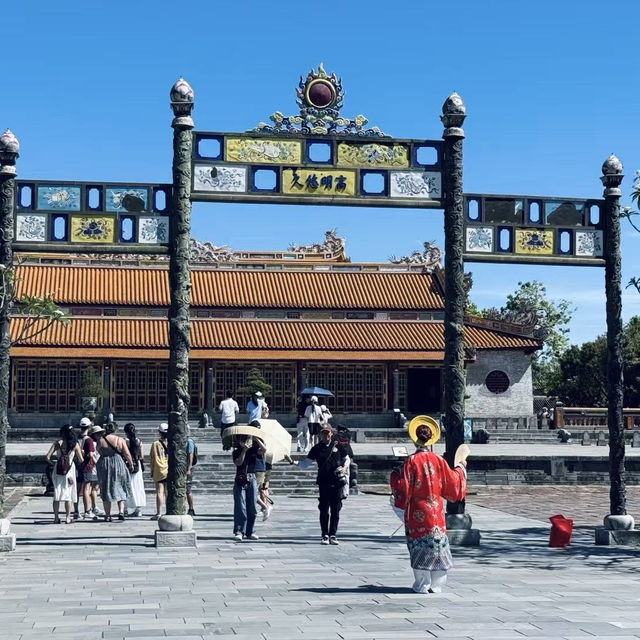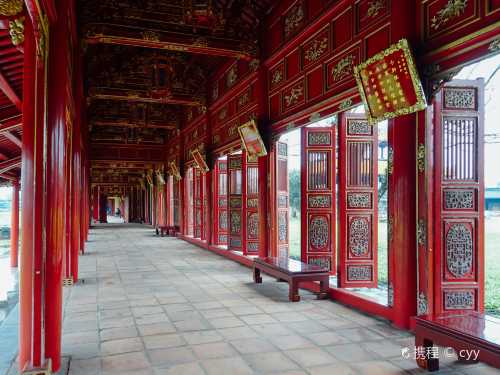App
Customer support
Find bookings
Hue is calling! 🏰 This city is loaded with incredible history, dreamy architecture, and unforgettable eats—perfect for anyone obsessed with culture AND good food. The highlight? An Dinh Palace: Western-style grandeur meets Vietnamese royal legacy. Top Spots to Visit: 1. An Dinh Palace (179 Phan Đình Phùng, Phú Nhuận, Huế) is hands-down a must-see for architecture lovers and history buffs! Pro tip: Go early (from 7AM) to dodge the crowds and truly soak up the vibe. The blend of European design and Vietnamese heritage makes every photo pop. Hue Food Guide: Don’t leave Hue without trying: - Vịt lộn um bầu (balut with gourd): Local favorite with rich flavor—best had at bustling markets or roadside stalls. - Tré trộn: Zesty mixed fermented pork salad, perfect for snacking. - Cơm hến: Signature rice with baby clams; iconic Hue street food, often sold near the Perfume River. - All kinds of Hue-style cakes (bánh): Bánh bèo, bánh lọc, bánh nậm—these delicate steamed treats are everywhere! Getting Around: Hue is walkable if you love exploring at your own pace, but grab a xe ôm (motorbike taxi) or use Grab if you’re short on time—cheap and efficient. The city is friendly for quick rides between main spots! Bonus Hue Hacks: - Arrive at attractions right at opening for the calmest, most photogenic experience. - Most locals prefer cash, so keep a stash of VND handy. - Weather can be hot and humid—pack sunscreen and water! #VisitHue #VietnamEats #AnDinhPalace #TravelTips #StreetFood
Trang ins barhighmost
Hue, Vietnam | Cửa Hiển Nhơn Gate: A stately gateway on the eastern side of the Imperial City, a silent watcher against the passage of time On the eastern side of the Hue Imperial City stands an ancient and dignified gate—Cửa Hiển Nhơn Gate. Compared to the grandeur of the Meridian Gate, it is more modest yet imposing. Once a key thoroughfare for the imperial court, it was frequently used by civil and military officials and inner court personnel, serving as a vital gateway to the eastern side of the city. Cửa Hiển Nhơn Gate's structure is built on a foundation of red brick and bluestone, with a roof covered in glazed tiles and arched doorways, reflecting the distinctive architectural style of the Nguyen Dynasty. The inscriptions on the gate, slightly tarnished by the passage of time, add to its ageless beauty. Approaching the gate, one can still sense the solemnity of the former Imperial City. Amidst the bustle of tourists, a tranquil atmosphere prevails. The afternoon sun reflects on the brick walls, creating dappled shadows that whisper of time.
諸文武
Hue, Vietnam | Ancient Charm: Tea and Leisure in the Deep Sea Tucked away within the solemn and majestic Hue Imperial City lies a tranquil corner—the Waterside. Compared to the towering city gates and magnificent palaces, this spot offers a tranquil retreat, a rare glimpse into the "slow time" of imperial life. The clear waters of the pond reflect the blue sky and the red-tiled roofs. Koi occasionally swim, and the ripples and reflections of the ancient trees on the shore interweave to create an elegant painting. Nearby, stone tables and wooden chairs were once the places where the royal family and literati would sip tea and converse. The wafting aroma of tea, carried by the gentle breeze, evokes the ancient pursuit of "nourishing the mind with tea and nourishing the spirit with scenery."
諸文武
Hue, Vietnam | Cửa Dục Khánh Gate in the Imperial City: A Quiet Entrance to the Imperial Palace's Backyard, Whispering Stories of the Nguyen Dynasty's Imperial Court Among the many gates of the Hue Imperial City, Cửa Dục Khánh Gate lacks the grandeur of the Meridian Gate, but instead embodies a tranquility and elegance. Located on the southeast side of the Imperial City, Cửa Dục Khánh Gate served as a secondary entrance to the inner court, once used by palace servants and inner court officials. Its presence is understated yet authentic. Cửa Dục Khánh Gate is a modest building, with a red brick and stone foundation, arched doorways, and exquisite glazed tiles and animal head decorations still visible on the roof. Compared to the main gate of the Imperial City, it is more austere, yet more attuned to everyday life. Passing through the gate, one is greeted by a tranquil courtyard and corridors, almost imagining the quiet movements of palace servants in former times.
諸文武
Popular Trip Moments
Chasing colors in Huế, Vietnam 🎨🇻🇳 | Banyan Tree Lang Co | Relax in the unbeatable pool villa overlooking the mountains and sea, plus an amazing SPA treatment! | Banyan Tree Lang Co, Vietnam|Cliffside Pool Villa + Stunning Sea View for the Ultimate Relaxing Vacation! | 🎨 Le Ba Dang Memory Space – Where Art Meets Infinity | Travel back in time to the Imperial City of Hue, Vietnam | A five-star resort where you can truly relax - Angsana Lang Co | HUE CITY | 😊✨ Huế: Imperial History & Riverside Charm 🇻🇳🌿 | The Ancient Capital of Hue, Vietnam's Last Dynasty (Nguyen) | Hue | Tan Lab Cafe | Banyan Tree Lang Co, Vietnam | Hue Royal Palace✨️ | Hue Royal Palace✨️ | Hue Royal Palace✨️ | Vietnam's Hue|Royal Boutique Hotel: Begin your journey in the ancient capital with a bowl of Vietnamese pho. | Vietnam's Hue | Thiên Mụ Pagoda: The Oldest Buddhist Tower by the Perfume River
Recommended Attractions at Popular Destinations
Popular Attractions in Paris | Popular Attractions in Walt Disney World Resort | Popular Attractions in Bangkok | Popular Attractions in Barcelona | Popular Attractions in Kuala Lumpur | Popular Attractions in Chefchaouene | Popular Attractions in Singapore | Popular Attractions in Beijing | Popular Attractions in Osaka | Popular Attractions in Las Vegas | Popular Attractions in Melbourne | Popular Attractions in Dubai | Popular Attractions in Bali | Popular Attractions in Iguazu National Park(Argentina) | Popular Attractions in London | Popular Attractions in Shanghai | Popular Attractions in Sydney | Popular Attractions in West Lake | Popular Attractions in New York | Popular Attractions in Tokyo | Popular Attractions in Rome | Popular Attractions in Kyoto | Popular Attractions in Los Angeles | Popular Attractions in Phuket | Popular Attractions in Zanzibar Island | Popular Attractions in Madrid | Popular Attractions in Chengdu | Popular Attractions in Florence | Popular Attractions in Istanbul | Popular Attractions in Jungfrau Region
Popular Restaurants in Hue
Cococlub Hue restaurant brasserie vietnamese & western | Cherish Restaurant | Nina's Cafe Restaurant | Les Jardins de La Carambole | Serene Cuisine Restaurant | RISOTTO Restaurant | Red Chili | Le Parfum | ZUCCA Restaurant | The One Coffee & Bakery | Ancient Town Restaurant | Hana Lounge Restaurant | Ben Xuan Garden House Theatre | COZY Restaurant & cafe | Mandarin Cafe | Burger Shack in Hue-Leu Hamburgers | Windows Cafe | Kyodai Japanese Restaurant | Lien Hoa | Golden Rice | HotTuna Restaurant & Bar | Spice Viet Restaurant | ECO -Restaurant | Brick Pub | Bar - Restaurant Ushi | Gecko Pub | Jalapeno Restaurant | Bangkok restaurant | Hoa Nghiem Vegetarian Restaurant | An Hien Bar & Cafe
Popular Ranked Lists
Top 50 Must-Visit Restaurants in Singapore | Top 50 Must-Visit Restaurants in Tokyo | Top 50 Must-Visit Restaurants in Shanghai | Popular Premium Hotels in Karbala | Top 50 Luxury Hotels near Naxos | Popular Luxury Hotels Near Varberg | Top 50 Best Things to Do in Vienna | Top 50 Best Things to Do in Milan | Popular Premium Hotels in Kirov Oblast | Popular Best Things to Do in Amman | Top 50 Luxury Hotels near Norwich | Top 10 Luxury Hotels near Anand | Popular Luxury Hotels in Nyeri | Top 50 Must-Visit Restaurants in Koh Samui | Top 50 Must-Visit Restaurants in Vienna | Popular Luxury Hotels in Barangaroo | Popular Premium Hotels in Nakhon Pathom | Popular Premium Hotels in Karbala | Top 50 Best Things to Do in Kyoto | Top 50 Must-Visit Restaurants in Chengdu | Top 50 Best Things to Do in Barcelona | Popular Luxury Hotels in Fes-Meknes | Top 50 Must-Visit Restaurants in Athens | Top 50 Best Things to Do in Ho Chi Minh City | Top 50 Must-Visit Restaurants in Chaozhou | Top 50 Luxury Hotels near Higashiagatsuma | Top 50 Best Things to Do in Saint Petersburg | Top 50 Must-Visit Restaurants in Bali | Top 50 Must-Visit Restaurants in Songyang | Popular Luxury Hotels in Dhaka Division
About
Payment methods
Our partners
Copyright © 2025 Trip.com Travel Singapore Pte. Ltd. All rights reserved
Site Operator: Trip.com Travel Singapore Pte. Ltd.
Site Operator: Trip.com Travel Singapore Pte. Ltd.


















